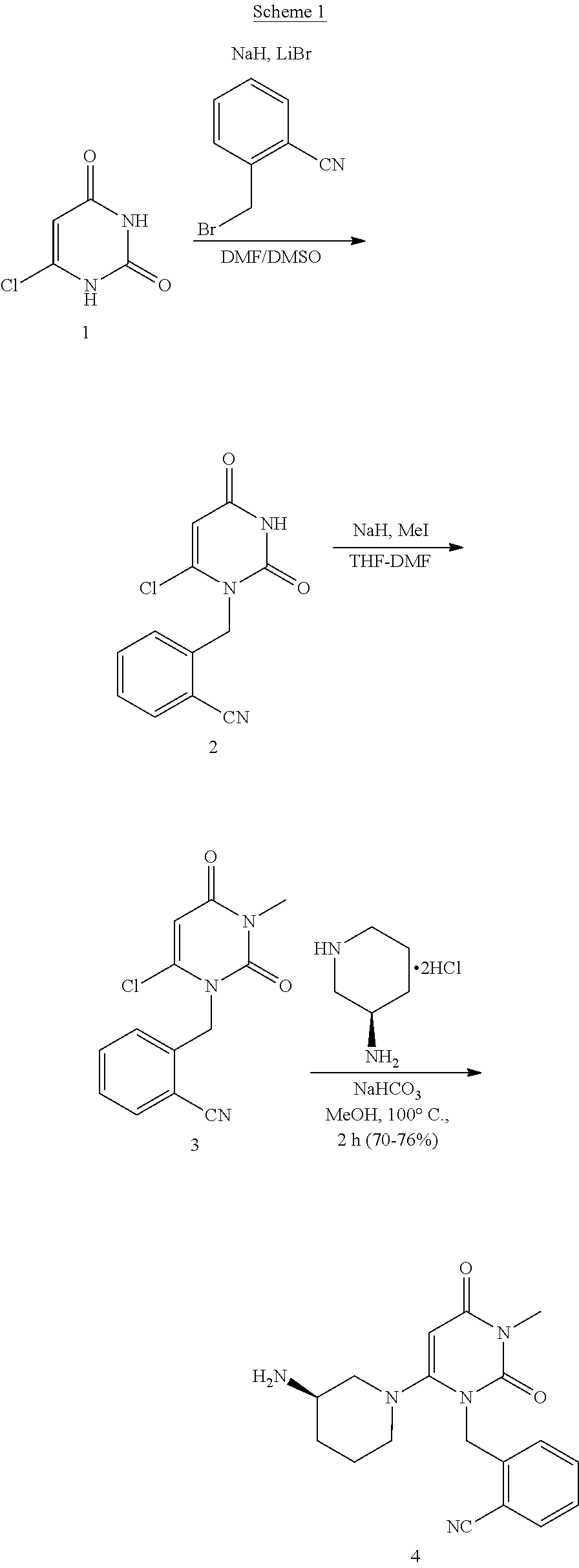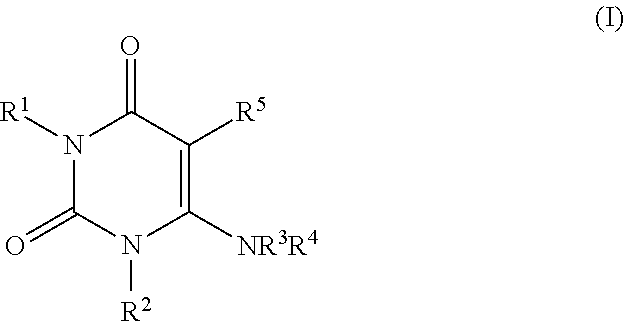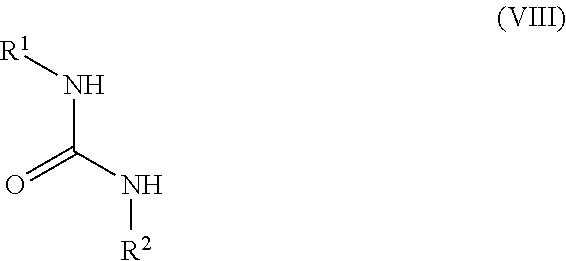Process for the preparation of alogliptin
a technology of alogliptin and alogliptin, which is applied in the field of process for the preparation of alogliptin, can solve the problems of uncontrolled diabetes, poor adsorption of alogliptin, and difficulty in separating and purifying mixtures of solvents with high boiling points
- Summary
- Abstract
- Description
- Claims
- Application Information
AI Technical Summary
Benefits of technology
Problems solved by technology
Method used
Image
Examples
example 1
Preparation of (R)-2-((6-(3-aminopiperidin-1-yl)-3-methyl-2,4-dioxo-3,4-dihydropyrimidin-1 (2H)-yl)methyl)benzonitrile (alogliptin) via 6-chloro-1-(2-isocyanobenzyl)-3-methylpyrimidine-2,4(1H,3H)-dione (Scheme 3)
[0126]
Preparation of 1-(2-isocyanobenzyl)-3-methylurea
[0127]2-cyanobenzylamine hydrochloride (90 g) and Dichloromethane (800 ml) were taken into a round bottomed (RB) flask. Methyl isocyanate (45.6 g) was added at 5° C. Triethylamine (81 g) in Dichloromethane (300 ml) was added at the same temperature and stirred at room temperature for 16 h. Water (1 L) was added and stirred for 30 min. The obtained solid was collected by filtration and dried in oven at 50° C. for 12 h. The yield is 85% and the purity 99.8%.
Preparation of 1-(2-isocyanobenzyl)-3-methylpyrimidine-2,4,6(1H,3H,5H)-trione
[0128]a). To a stirred solution of 0.11 mol of sodium ethanolate in 80 ml of ethanol abs. was added 0.1 mol of 1-(2-isocyanobenzyl)-3-methylurea and 0.1 mol diethyl malonate. The mixture was ref...
example 2
Preparation of (R)-2-((6-(3-aminopiperidin-1-yl)-3-methyl-2,4-dioxo-3,4-dihydropyrimidin-1(2H)-yl)methyl)benzonitrile (alogliptin) via 6-amino-1-(2-isocyanobenzyl)-3-methylpyrimidine-2,4(1H,3H)-dione (Scheme 4)
[0139]
Preparation of 6-amino-1-(2-isocyanobenzyl)-3-methylpyrimidine-2,4(1H,3H)-dione
[0140]a). 1-(2-isocyanobenzyl)-3-methylurea (0.2 mol) and cyanoacetic acid (0.22 mol) were dissolved in acetic anhydride (400 ml), and the mixture was heated at 80° C. for 2 hours. Acetic anhydride was distilled off under reduced pressure and water (200 ml) was added. The mixture was cooled to 0-5° C. and 2N NaOH solution (220 ml) was added and stirring was continued for 2 hours. The obtained solids were filtered off, washed with cold methanol and dried under vacuum. The yield of 6-amino-1-(2-isocyanobenzyl)-3-methylpyrimidine-2,4(1H,3H)-dione was 72%.
[0141]b). Under nitrogen atmosphere, 1-(2-isocyanobenzyl)-3-methylurea (98.4 g) and cyanoacetic acid (80.0 g) was added to N,N-dimethylformamide...
PUM
| Property | Measurement | Unit |
|---|---|---|
| temperature | aaaaa | aaaaa |
| time | aaaaa | aaaaa |
| temperature | aaaaa | aaaaa |
Abstract
Description
Claims
Application Information
 Login to View More
Login to View More - R&D
- Intellectual Property
- Life Sciences
- Materials
- Tech Scout
- Unparalleled Data Quality
- Higher Quality Content
- 60% Fewer Hallucinations
Browse by: Latest US Patents, China's latest patents, Technical Efficacy Thesaurus, Application Domain, Technology Topic, Popular Technical Reports.
© 2025 PatSnap. All rights reserved.Legal|Privacy policy|Modern Slavery Act Transparency Statement|Sitemap|About US| Contact US: help@patsnap.com



